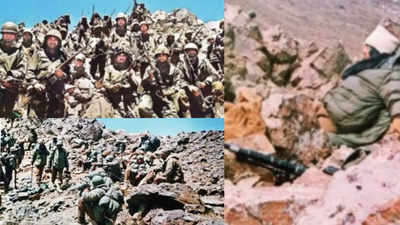- News
- City News
- shimla News
- War hero's drass flashback just one intel!
Trending
War hero's drass flashback just one intel!
In the Kargil war, our relentless efforts led to the recapture of Tololing, showcasing the bravery and sacrifice of our troops. Despite facing unknown enemy strength and harsh conditions, we persevered with courage and determination, ultimately securing strategic victories in the challenging terrain.

“It was my 2IC (second-incommand), Lieutenant Colonel R Vishawanathan, at the other end,” the war hero, now 70, recalls while sitting in the drawing room of his spa cious, green-roofed house at Nagwain in Mandi district of Himachal Pradesh.The commander had orders to move his counter-insurgency infantrymen from the Ganderbal area of Kashmir to a blind, unmapped battlefield.


White soil dyed red
The next day, the brigadier flew from Chandigarh to Srinagar and, on May 16, rejoined his troops in a highaltitude cold desert Drass, where at the temporary base, he received a casual military brief: “Drag a few militants down from the Tololing Top.”
The task of capturing that peak turned out to be one of the bloodiest, toughest, and prolonged battles of the Kargil war, in which Brig Thakur lost 25 of his finest soldiers, including two officers — Lt Col R Vishawanathan and Major Rajesh Adhikari.
The war veteran said: “Everybody was in the dark about the enemy’s strength, weapons, and positions. When my briefing officers told me that the militants had cut off our supply lines through the Srinagar-Leh highway, I assumed there could not be more than four to five mujahideen in the garb of regular soldiers on the Tololing Top, while Pakistan had posted an entire company of its North Light Infantry on the peak. It was an utter intelligence failure.”
One bullet away
The Indian soldiers didn’t even have maps, snow gear and boots, or any artillery support. In front of them lay a rugged mountain of 16,000 feet and a well-equipped enemy in a vantage position.” Reclaiming Tololing took one of the country’s bravest high altitude battles under freezing temperatures for 22 days.
Brig T hakur’s boys
launched their attack on May 22 with just boulders to shield them from the hail of bullets. They would crawl inch by inch at night and duck behind the rocks by day and lay still. If any soldier stood up, the enemy snipers could take him down, so it was tough to answer even nature’s call. Relentless firing led to many casualties, and in that terrain, it required 5 to 6 men to tend to an injured soldier. The night temperature was sub zero, but, for the fear of snipers, you couldn’t even light a fire.
Losing your shadow
The big offensive of the night between June 2 and 3 also came in the crosshairs of the enemy’s artillery guns. “Lt Col Vishawanathan was leading the attack when I saw him take a hit. Soldiers carried him to me, and he died in my lap,” Brig recalled, staring into the vacuum of the past.
Radio operator Ram Kumar had crawled beside the Brig, who recalls: “At some point, I asked him why he wasn’t moving, and when he didn’t respond, I looked back to find him dead. The loss of 13 men forced us to retreat. The situation was more serious than made out to be, and so the extra build-up of troops began.”
No rest till victory
On the night between June 12 and 13, the 18 Grenadiers and 2 Rajputana Rifles mounted a joint attack on the Tololing Top. By the morning, the peak was recaptured in among the war’s first strategic victories. Brig Thakur’s men were ordered without rest to capture the Hump between Tololing and Point 5140. He lost 12 boys there on June 13 and 14. A few bullets flew past him, too. Capturing the Tiger Hill at 17,500 feet was easier. We had the intel, arms, resources ,and 8 Sikh on the hill. The fight began on July 3, and the tricolour was atop it by July 4.
End of Article
FOLLOW US ON SOCIAL MEDIA










